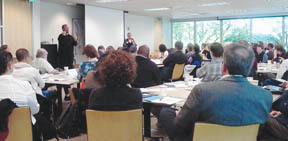 |
||||||||
| MEMO BLOG | Memo Calendar | Memo Pad | Business Memos | Loaves & Fishes | Letters | Home | ||
 |
 |
 |
 |
 |
 |
LEE PERLMAN
THE MID-COUNTY MEMO
 |
| In February and March, the Portland Bureau of Planning and Sustainability is holding a series of public workshops to get public input on draft proposals for the Portland Comprehensive Plan update. David Douglas High School hosts one March 2. COURTESY BUREAU OF PLANNING AND SUSTAINABILITY |
A matter of particular interest will be a series of potential growth scenarios the Bureau has developed, planner Spencer Williams told the Planning and Sustainability Commission last month. The city expects to gain 132,000 new inhabitants and 150,000 new jobs by the year 2035, and the scenarios are plans for how they should be absorbed, he said. One is “default”: simply put, allow development to proceed as it has. Another is to concentrate development in and near commercial “nodes”, such as Gateway. Still another is to place growth along transit corridors such as Northeast Sandy Boulevard, Southeast Stark Street, or 102nd or 122nd avenues. Finally, the city could concentrate growth into the central city.
Metro's 2040 Plan, upon which current zoning is based, “provides a lot of capacity but not much focus,” planner Tom Armstrong said. “This allows us to decide how we want to grow and where we want to grow.”
Depending on the scenario, east Portland would grow by from 20,000 to 40,000 households.
Planners are also analyzing how the scenarios will help implement city goals contained in the Portland Plan adopted earlier this year. For instance, it called for 80 percent of all Portlanders to live in complete neighborhoods, with most services and destinations within walking distances, and 80 percent of Portlanders to live within a quarter mile of frequent transit service. Currently 45 and 47 percent of residents, respectively, enjoy these ideals. Under the scenarios, the numbers would increase to 48 to 53 percent for complete neighborhoods, and 53 to 56 percent for good transit access.
“There are a whole lot of variables other than zoning,” Planning and Sustainability executive director Susan Anderson said.
Commission member Howard Shapiro said, “It seems to me you'll have to rely on sister agencies such as TriMet, and they're not always a willing sister.”
Armstrong responded, “We can start by stating our priorities.” Another way is to decide where and how the city invests in basic infrastructure. “Our current system allocates growth, but not investment. Investment could lead (TriMet) to confidence that if they improve service, it will result in increased ridership.”
The question of where and how to invest is tricky, however. On one hand, the city feels the need to use its scarce resources efficiently, seeking cost-effective solutions and leveraging federal and private money whenever possible. On the other hand, under the Portland Plan's goal of equity, city leaders feel an obligation to provide basic services to parts of the city that do not have them, often a costly proposition.
Commission member Karen Fischer Gray, who is also superintendent of the Parkrose School District said, “The equity issue is huge. The decisions we make can make the rich richer and the poor poorer. Equity means we all have access to the same stuff.”
On the other hand, Commission member Michelle Rudd said, “We need to be strategic, and take advantage of partnerships and matching funds. We certainly don't want to turn our backs on potential resources. We don't want all school kids forced into one area.”
Anderson said, “Many of our goals and policies will always be in conflict, and will need to be balanced.”
Several commission members questioned how much of the Comprehensive Plan is still open to discussion, and whether the workshops in some cases will simply review decisions already made. Planner Sandra Wood replied, “No, the whole thing is open to discussion, although some things are more open to discussion than others. It's difficult for the public to provide input on the whole 200 pages at once.”
Still, Anderson said, “We're accused of taking out a plan that's all done, and this isn't that at all. This is definitely not baked.”
MEMO Advertising | MEMO Archives | MEMO Web Neighbors | MEMO Staff | Home
